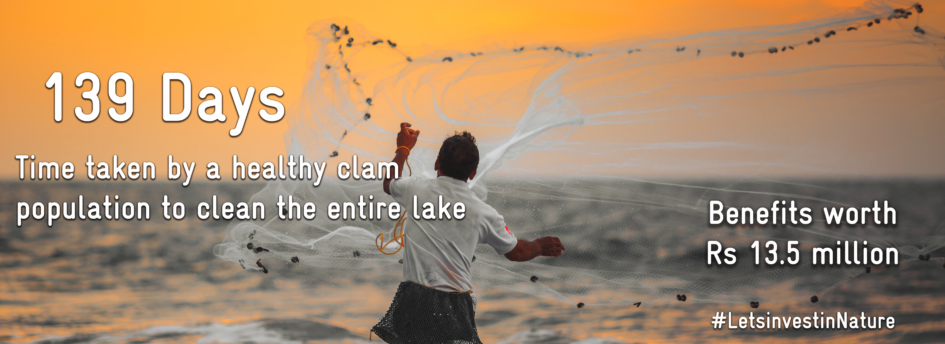Shubhangi Singh: Often, there are circumstances that threatens to erode the very fabric of our existence by shaking the foundations of what our livelihood, our economic structures, and our communities depend upon. While some may have no choice but to be engulfed by these unfortunate conditions, others look inwards for solutions that may induce responses that could, potentially, improve the looming cataclysmic situation.
This is a story of one such case when a community banded together to seek out solutions against an oncoming disaster, thus, averting what could have been a rather frightful and unfortunate ruination. This is a story that emerges from God’s Own Country where much depends on the respectful exchange between man and nature.
Spanning 61 sq.km, the Ashtamudi Lake is considered the gateway to the backwaters of Kerala. While the lake on the outside radiates with natural beauty, there is notable treasure nesting deep within it’s waters – the short-neck clams. The Ashtamudi estuary provides livelihood for as many as 3,000 locals and the estimated value of fishery resources of this lake is approximately 985 million in rupees (US$ 16.4m), of which, close to 51% of this amount comes from trade of clams acquired within this region. Apart from proving to be a significant asset for trade and sustenance of the local fisher population, these clams play a key role in maintaining the health of the waters they exist in and, therefore, affecting all associated bio-activity conducted within. Clams function as natural bio-filter for the waters. The amount of nutrients released in the water where clam beds exist has been proved to be thrice as much as non-clam zones, hence, with more clams, it could take approximately 139 days to filter the lake water completely, as opposed to 277 days where clam presence is poor. This factor, most certainly, claims Ashtamudi’s clams in a position of being an indispensable component in the lake’s natural operations.
Throughout 1980s and 1990‘s, soaring demand for these superior quality products pushed clam fisheries in Ashtamudi to it’s peak. In the year 1991, close to 10,000 tonnes of clams (annually) were mined from the estuary but by 1993, the catch had declined by a whopping 50% due to overfishing. The overlooking of this indiscriminate fishing resulted in steady deterioration of the lake’s overall health and a drop in the quality of the clams in the region, affecting trade and income for the local fishermen. Soon enough, along with the experts and eco-observers, the small scale clam fishers recognized the glaring issue as well as its impending damage to the larger ecology and voluntarily adopted sustainable practices to help salvage the situation. With guidance from the experts, the community came together to respond to the circumstance of depleting clam population in the lake by adopting sustainable practices like minimum mesh size of their nets while fishing so as to refrain from catching juvenile clams, prohibition of mechanical clam fishing that exercise mass and indiscriminate fishing practice and endorsing fishing holiday that comes into effect between December and February each year during the breeding season to help replenish the clam mass. Thanks to these efforts on the part of all stakeholders of the lake’s resources, nature was given a chance to renew itself resulting in the clams to slowly limp back to their earlier stature, thus, improving the condition of the lake as well as that of the locals depending on it for their livelihood.
This transformation of the lake’s condition has certainly not gone unnoticed but has, instead, attracted several accolades and well as recognition for the persistent effort gone behind the lake’s restoration. Post restoration, the short-neck clam fisheries of Ashtamudi Lake in Kerala has also received the prestigious Marine Stewardship Council title – India’s first eco-label in sustainability certificate. The label ensures that Ashtamudi follows the best practices in natural resource management, hence, opening up new markets that further fetch a premium price for the Ashtamudi clams. The value of the clam fishery in the Ashtamudi estuary has now been estimated at a cosy Rs. 13.5 million (annually).
With always room for more improvement, at this stage, Ashtamudi is in a steady health, thanks to the renewed population of bio-filtering clams which has also provided a much needed boost to fishery and other resources like edible vegetation found in the lake. In a case of community-lead and practiced improvement, a little awareness and effort went a long way in bringing Ashtamudi and the short-neck clams back from the brink.
This is a story which tells us how collaborating with nature as opposed to challenging it will strengthen and magnify the benefits sought by the stakeholders. This is a story where small steps snowballed into a life and economy fortifying act that, undoubtedly, would have long-term results. This is story where Ashtamudi has successfully secured it’s clams for the present and (hopefully) for a long run in the future by investing in nature.

